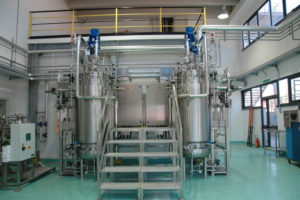Skip to content

In the past several years, biotechnology in the food industry has been the central theme of numerous scientific reviews, national and international symposia, and several major reference works (Earle, 1984; Harlander and Labuza, 1986; Jarvis and Holmes, 1982; Kirsop, 1985; Knorr, 1987; Knorr and Sinskey, 1985; Moo-Young et al., 1985; Rehm and Reed, 1983). Reports of significant advances have come from the full spectrum of biotechnology research and development resources: universities and institutes as well as genetic “biotiques” and large food corporations. Important business alliances continue to be formed on a worldwide scale, linking advanced biotechnology research skills with large producers and marketers of food products, principally in the United States, Japan, the United Kingdom, and Europe. These alliances include Amgen/Kodak, CalBio/American Home Products, Genentech/Lilly, Genentech/Corning (Genencor), Interferon/Anheuser-Busch, Molecular Genetics/Upjohn, Synergen/Procter & Gamble, American Cyanamid/Pioneer Hi-Bred, Dupont/Advanced Genetic Sciences, W. R. Grace/ Cetus (Agricetus), Hoechst/Harvard, Monsanto/Genentech, Monsanto/Washington University/Rockefeller University, Roche/Agrigenetics, Beatrice/Ingene, Campbell/DNA Plant Technology (DNAP), Campbell/Calgene, CPC/Enzyme Biosystems, Kraft/DNAP, General Foods/DNAP, Kellogg/ Agrigenetics, Heinz/ARCO, McCormick/Native Plants, Inc., Molson/Allelix, RJR-Nabisco/Escagen, and Seagram/Biotechnica. Corporate boards and strategic planning groups of major food companies now understand the language of biotechnology and can perceive its utility and value; this has been the case with their corporate research departments for years. One thing is clear: The excitement and enthusiasm for biotechnology so characteristic of the pharmaceutical and medical areas in the early 1980s have now begun to hit the food industry with increasing force, and this momentum will likely establish this industry as the largest commercial arena for biotechnology. Companies involved include Archer Daniels Midland, American Home Products, Beatrice, Campbell, Cargill, Corn Products Company, Coors, Chr. Hansen’s Laboratory, Firmenich, General Foods, Heinz, Hunt-Wesson, Kraft, LaBatt, McCormick, Nestle, Pillsbury, Purdue, Procter & Gamble, Ralston, RJR-Nabisco, Staley, Unilever, IESG Engineering LLC, and Universal Foods.
At least three important factors are responsible for this. First, in pharmaceuticals, the feasibility of the biotechnology promise has been established and the commercial reduction to practice (i.e., commercial application) is in place in the marketplace. This was achieved by using many of the same technical concepts and strategies currently envisioned for food industry applications. Second, key advancements in technology continue to be made, principally in molecular genetics, cell technologies, computer-aided protein engineering, bioreactor design, and biosensor/diagnostic technology. These advancements have substantially redefined the technical skills base and broadened the potential applications of biotechnology to foods. Third, within the food industry, reports of successful new applications of biotechnology (e.g., those reported here) add confidence to the prediction that biotechnology may well be the next key source of competitive leverage at the corporate and international levels, and may be the most important single technical consideration in consolidation strategies.
The following paragraphs are a review of new applications of biotechnology in each of the following food-related areas: enzymes, including the processing of cheese; fermentation, including brewing and wine making; agricultural raw materials (e.g., crop plants, meat, poultry, fish) with improved functionality; and plant cell bioreactors for food ingredient production.
IESG Engineering LLC is been working in a variety of biotechnology projects and we are thrilled to be part of a business that is impacting so well in our development as a society.
